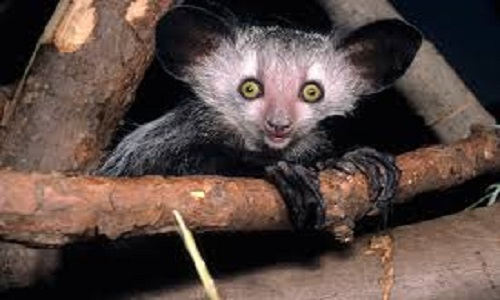4,410 total views, 1 views today
The Aye-aye is an animal of the family of lemurs that lives and is found in Madagascar. They are very active animals at night and are known to be the largest nocturnal primate. The animal is probably not well known because of the rate at which its population has decreased over time, making them to be classified as endangered species. At the onset of their discovery in their native habitats, it is known that the people would often kill them because they thought the animals carried some sought of very bad luck.
Although they have been classified as mammals, they show characteristics that belong to different other classes such as the class of birds, and a few different orders too, thus their classification into the order of primates is not very certain. Structurally, they are seen to possess lengthy ears, very round large eyes that appear so obvious on their frontals. Young aye-ayes look different in colour as compared to the matured individuals. They are silver coloured at the front with a stripe which runs down their back. At maturity, the individual gets covered in thick fur which would be of different colours.
Features of The Aye-aye
Notable features of the Aye-aye would include a tail that is quite extended and as long as the animal itself. In length, the average for a matured member is put at about three feet. They have short hind legs which qualify them as lemurs, but their skeletal structure is made to resemble that of the rodent. Another salient feature is their finger structures. There are five fingers; the third finger is thinner than the others and is used for tapping and grooming. The longest on the set is the fourth, used for pulling bugs out of trees.
Foraging is the method used in sourcing for food. Since they are arboreal- living on trees, they get/eat their food from potential preys that they can find on the trees. They have excellent adaptation that assists them in their look for food. Aye-ayes are able to gnaw into trees using their forward slanting incisors to create small holes from which they pull out grubs using the middle finger.
Aye-ayes spend most time of the day sleeping. Their nests are spherical structures that are built out of leaves and branches, placed between the forks of tree branches. They exhibit behavioural lifestyles such as that in which the male are seen to tolerate each other- living in a same nest, although not at the same time. Mapping of territory is a lifestyle that the male population has adopted, even though this mapped territories often times overlap with the territories of the others; they would not bother as long as there is no female around.
They are solitary animals and would often mark their territories with scent. In mating and reproduction, male aye-aye compete to mate the females as she calls them. The female aye-aye takes longer to develop sexually as compared to the male. The female attains maturity from about three to three and half years and can start reproducing, while the male is sexually mature from about two and half years. Mating is not seasonal and may occur anytime the female is ready to mate. She has an increase in genital size as a way of attracting the males. Pregnancy is held for about 6months before delivery and has many similarities with higher mammals. Weaning of infants may be as early as 7 months, but would continue to nurse with the mother as long as she is within reach.
Other than threats from local indigents who had superstitious believes about the animal, one major challenge faced by the aye-aye remains that, there is an increasing decrease in their habitat. This is due to human activities such as farming and building activities. And since they can only seem to survive in the arboreal strata, their number begins to cut down when the trees are no more.
Concerted efforts to save the aye-aye have yielded results, except for the villagers that continue to kill them. From the time they were rediscovered in the 1980s and their numbers have been kept steadily constant at least. Some of them have been captured and locked up in reserved centers in a bid to ensure they are not left in the very wide where they could easily be killed. Such reserves park includes the Nosa Mangabe island, located along the north-east coast of Madagascar.
If you find this article interesting, please like us on Facebook and Twitter, you should also share it by clicking the buttons below to enable other people to benefit from it.
